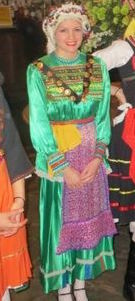
The Dodecanese Islands
The Dodecanese Islands are a group of 12 main islands along with many other smaller islands located in the southern portion of the Aegean Sea. Some of the most well known islands of the dodecanese are Kalymnos, Karpathos, Kos, Leros, Patmos, Rhodes, Symi, and Tilos.
Popular dances from the Dodecanese Islands
Antipatitis (Karpathos), Arkistis (Karpathos), Kalymnikos (Kalymnos), Katos Horos (Karpathos), Kamares (Tilos), Mihanikos (Kalymnos), Panos Horos (Karpathos), Pidihtos (Rhodes), Sousta (Kalymnos), Sousta (Karpathos), Sousta (Leros), Sousta (Rhodes), Sousta (Symi), and Zervos (Karpathos)
Costumes from the Dodecanese Islands
| This bridal & festival costume is given the name of its most important garment, the “kava(d)i.” The “kava(d)i”, which was worn after a girl’s 15th birthday in Karpathos, is a long coat with aesthetics elements reminiscent of Byzantine fashion. This costume was particular to the eldest daughter of the household (the “kanakara”) and is currently worn in the village of Olympos. The costume contains a white chemise, a cotton apron, and a sash. Gold coins always accompany this costume since it is one of the oldest costumes of the aristocracy. The headdress, which consists of scarves once obtained from Smyrna or Constantinople, is a characteristic facet of this costume. |  |
 |
||
| The Sakkofoustano was the costume worn by the unmarried girls and brides of Olympos, Karpathos. It consisted of two parts: the skirt and the "sakko." This costume set itself apart from others because of its vivid colors, fancy embroidery, and sequins. As headpieces, they wore a scarf, decorated with flowers, with hanging braided colored beads. |  |
 |
||
| The female costume of the village Embona, Rhodes is considered the most impressive of all the traditional costumes in the 42 villages of Rhodes. It has a white shirt, which in the local dialect is called “malola.” The village of Embona had cotton silkworms and sheep to get the raw material for these colorful costumes. The upper skirt is full of colors with beautiful designs and patterns. To complete the striking costume of the island, the women wear a colorful headscarf (the “akrivomantilo” or “tsoullato”). The “akrivomantilo” has fringe and often becomes a handkerchief for the women to perform with after a few minutes of dancing. Numerous argue that the materials used in weaving the costumes, such as colored silk textiles, wool, and cotton, became a model for the creation of other folk costumes. |  |
 |
||
| From an early age the girls of Kalymnos wore costumes with a long coat, called the “kavadi.” A white dress with bold embroidery on the chest and the edges was worn first. The “kavadi”, which was sewn from heavy fabric in various shades and patterns, was worn over the dress. The front of the chest was open to showcase lace and jewelry. The edges of the sleeves were folded to show the inside fabric of the “kavadi.” A striped belt is also added to the costume to cinch the waist. |  |
 |
||
| This costume, worn by brides and engaged women of the island of Astypalaia, is called the “chrysomantilo” in the local dialect due to the gold (“chryso”) embroidery and pearl decoration on the headdress (“mantili”). Stylistically, it has features that are reminiscent of Byzantine dress and costumes. The headdress has, at its base, an embroidered cap and two embroidered silk scarves (the “bolia”), one white and one yellow. It is decorated with flowers and secured with stickpins (“kombovelones”). The costume of Astypalaia is well-known for its embroidery on the long-sleeved dress. |  |
|||
